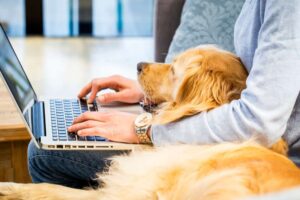Preventing separation anxiety

As a dog owner, Lockdown has meant working from home which for many has been great as you don’t have to worry about finding someone to walk your dog, you have excuses to take breaks throughout the day, and (bonus!) and you get to work with the best coworker!
But, are you giving your dog enough time alone?
Dog owners who work from home or are retired and home most of the time are becoming faced with dogs who have become used to constant companionship. These dogs then have a tough time being left alone for any time at all, and if the owner’s schedule or lifestyle changes (like the last look down and people began to return to work!) they were no longer present all of the time, and some dogs had a very tough time adjusting.
If your dog never gets used to spending time alone or learning how to entertain themselves, they can start to develop separation anxiety.
What is separation anxiety?
If you are a dog owner, it is likely you have heard the term before. ‘Separation Anxiety’ is a behavioural term for when dogs become stressed and frantic whenever they are left  home alone. It is a well-known fact that dogs are pack animals and thrive being part of a pack. Although dogs are now domesticated, this group mentality hasn’t changed, so most dogs prefer it when their humans are home, and the pack is together. Different breeds of dog can be more-or-less prone to experiencing separation anxiety and dogs who have come from rescue situations may also fall into this category.
home alone. It is a well-known fact that dogs are pack animals and thrive being part of a pack. Although dogs are now domesticated, this group mentality hasn’t changed, so most dogs prefer it when their humans are home, and the pack is together. Different breeds of dog can be more-or-less prone to experiencing separation anxiety and dogs who have come from rescue situations may also fall into this category.
A real-life scenario:
A close friend of mine worked from home for almost a year when she decided to get a puppy. She had been wanting to add a dog to her family that would keep her company during the day and get her out of the house more. Working from home was the perfect solution to the frequent potty breaks and playtime that many friends had to take time off work for or hire a dog walker.
Once she brought the puppy home, she was there to make sure she had the right amount of care throughout the day. She was a doting new pet parent, and she was the most adorable little desk sidekick.
Fast forward a couple of weeks, and she learned that Mary Berry had a tough time when they left the house. Even if they just left to take the bins out, she would sit at the door and cry until they returned. Rather than helping to shape a puppy that liked her independence and time alone, they had inadvertently fostered the behaviors of the Velcro dog.
Now that she no longer works from home, they are constantly working on conditioning Mary Berry to being left alone for periods of time. She has a dog walker who comes at lunchtime to get her out of the house for a potty break, and is lucky that she also gets to bring Mary Berry to work a couple days a week.
Though she’s still a puppy, she displays many behaviors associated with separation anxiety. For that, I highly recommend making sure to leave your puppy on a regular basis, so they can get used to being independent and used to doing things on their own.
How to combat Separation Anxiety:
SuPaw Nanny has pulled together information to help you and your dog through some of the issues lockdown separation anxiety can cause.
What behaviours will dogs experiencing separation anxiety display?
Dogs who are experiencing separation anxiety may show any of the following behaviours when left alone:
– Vocalisation such as howling or barking
– Destructive behaviour such as scratching walls and doors, or chewing furniture and other items
– Going to the toilet indoors
– Hyper salivating or panting
– Increased heart and respiration rate
These behaviours are caused by stress and anxiety triggered by you leaving the house and can be very distressing for both us and our dogs.
How do you help prevent dogs from developing separation anxiety?
 There are always going to be situations where you need to leave your dog at home on their own regardless of lockdown. So, the real trick is starting early and getting your dog (or puppy) used to being left from the moment you bring them home. This way when you do need to leave the house it becomes normal and know you’ll return.
There are always going to be situations where you need to leave your dog at home on their own regardless of lockdown. So, the real trick is starting early and getting your dog (or puppy) used to being left from the moment you bring them home. This way when you do need to leave the house it becomes normal and know you’ll return.
To begin, try leaving your dog in a different room, if only for a few minutes.
Try leaving high value dog treats, or a toy that they love. And when you come back into the room don’t make a fuss of your dog, as this needs to feel ‘normal’.
Build this up for longer periods, now it’s time to start leaving the house. Choose the same place to leave your dog whilst they’re getting used to be alone, this might be a crate for puppies, or a certain room or area of the house. The main messages here are to start as you mean to go on. Leave home to carry out your essential shopping/medical supplies/exercise. And on your return put your bag, keys, shoes, shopping away as normal before giving your pup attention.
Working from home with a dog:
When you first get a puppy or new dog, it can be tempting to make sure that you’re there for them all the time, but doing so can create a dog that follows you around everywhere. When you work from home, there’s always a chance that your dog can become more attached to you than normal, potentially causing separation anxiety.
Rather than learning how to entertain themselves, they turn to you to provide all of their entertainment, which builds their dependence on you.
If you work from home, it’s very important to leave your pet elsewhere in your home, away from you and your work station for at least a couple hours per day to make sure your dog is able to be left alone without displaying severe signs of stress.
Start off in short increments: 15 minutes to a half hour at a time, then increase over time. Again, remember to leave out a few fun toys – and make sure that you only bring out these specific toys when you’re removing yourself from their area (ie taking yourself ‘off to work’ in a separate area of your home’ and leaving your dog alone – these ques will signify to your dog that you leaving is actually AWESOME!
 Tips working from home:
Tips working from home:
Here are some tips for working from home that can help your dog get used to spending time alone:
– Work from someplace else: If you work from home, you know that sometimes you need to get out of the house. Try taking your work to the nearest coffee shop, library, co-working space, or (during lockdown!) even a separate area of your home from where your dog is hanging out – and make sure they don’t follow you! This conditions them to spending more time alone.
– Use a crate or “puppy zone”: Crate training can really help your dog get used to spending time alone. Try crating your dog for a couple hours while you work from another room. I’ve shared some tips on crate training in a separate blog!
– Encourage independent play: Try to encourage your dog to spend time in a room other than you when you’re working from home. An interactive puzzle toy or Kong tethered in place will keep your pup entertained and tire them out at the same time.
I hope this is useful, if you have questions or want to share your story about working from home with your dog, feel free to comment below.
We look forward to hearing from you!
As always, we hope this information has been useful.
Regards,
SuPaw Nanny

